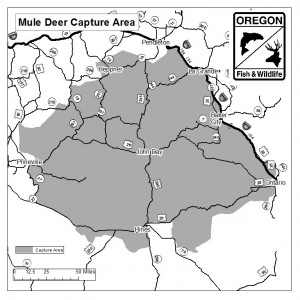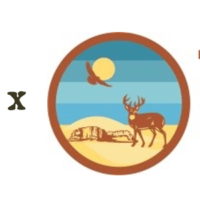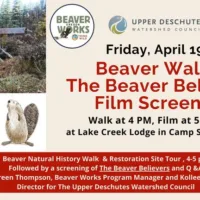
GPS data will improve ODFW understanding of deer ranges, movements
Salem, Ore.—Data from 500 GPS radio collars will soon replace an older population model and conventional wisdom about mule deer in the southern Blue Mountains.
Beginning March 1, about 500 adult female mule deer between Prineville and Ontario will be collared so wildlife managers can better understand their ranges and movements.

Leading Edge Aviation, a company based in Clarkston, Wash., will be handling the deer capture. The capture operation could take 10 days or more depending on weather conditions. Capture activities will take place on public land and on some private land where ODFW has permission of the landowner.
The mule deer captures will be done by helicopter. First, the deer will be located by helicopter crew and then captured using a specially-designed net gun. Once netted, deer are blindfolded and restrained to calm them. Each deer captured will be fitted with a GPS radio collar and then released on site. The capture process typically takes just 5 or 10 minutes for each deer. This limits handling time and reduces stress on the deer.
The GPS collars automatically transmit location data via satellite and can be programmed to provide data up to several times a day. They also emit a special “mortality” signal when the collared animal stops moving for a prolonged period. Once the mortality message is received, ODFW biologists can use the collar’s transmitted position to find the deer and potentially determine the cause of death. The collars typically have a three-year battery life.
Wildlife managers intend to monitor collared deer movements from summer through winter, to determine if they go to the same place every year. Deer typically spend summer at higher elevations but migrate to lower elevations when snow makes it difficult to forage in the high country.
In Oregon, big game tags and hunting seasons are managed under 67 Wildlife Management Units originally established in the 1950s. But these boundaries may not align with current mule deer behavior. For example, some deer herds may summer in one unit and winter in another.
“Historically, we have managed mule deer herds based on data from a 1960s population model and conventional wisdom on how they are distributed among Wildlife Management Units,” said Chip Dale, ODFW Klamath and Malheur Watersheds Manager. “When we did a similar deer study in central Oregon, we found out that movements and distribution had changed.”
“Some unit boundaries reflect animal distributions well and some don’t,” Dale continued. “We want to do a better job of determining what’s going on with mule deer herd ranges by using the GPS data.”
“Our unit boundaries are socio-political and may not line up with what deer herds are actually doing,” adds Ryan Torland, district wildlife biologist for Grant County. “For example, many deer that spend winter in Murderers Creek are in Silvies Unit during hunting season.”
ODFW’s purpose in the study is not to change wildlife management units. Instead, information gathered from the study could change how populations are monitored through updated population modeling techniques. Eventually, this information could lead to hunting season changes so tags better align with actual mule deer movements. “For example, when herds are spending time in two different units, tag changes would occur in both,” Torland said.
The study complements other ODFW efforts to improve understanding of mule deer in Oregon. In the past few years, ODFW has also adopted a new survey method in some units. Known as quadrat sampling, it involves flying randomly chosen one-square mile areas to count deer. It is a more rigorous, statistically based method than traditional trend surveys, which count deer along the same route each winter.
Funding support for the collaring project comes from the sale of hunting licenses, and the Wildlife and Sport Fish Restoration Program, a federal grants program funded by excise taxes on the sale of hunting equipment.
Mule deer live east of the Cascades and are one of three deer sub-species found in Oregon. They are one of Oregon’s most popular species to hunt and view. More than 66,000 people hunted deer in eastern Oregon in 2013.
If you see local news happen, call the Horizon Broadcasting Group News Tip Hotline at 541-323-NEWS, or email us.















